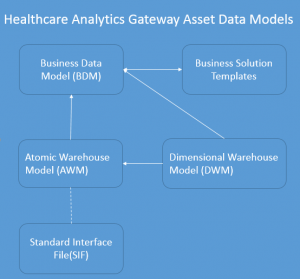UDMH Model Components
The Perficient Healthcare Analytics Gateway asset is a data integration engine that allows healthcare data from multiple sources be integrated and presented in atomic level detail (Inmon model) and in conformed dimensional layer (Kimball model). The atomic and dimensional data models are part of IBM’s Unified Data Model for Healthcare (UDMH). IBM Unified Data Model for Healthcare offers a robust set of business and technical data models, that are extensible and scalable to fit the unique requirements of the Healthcare industry. The UDMH components comprise of industry-specific terms (vocabulary) and related data models, and the SIF (standard interface file) model was created by Perficient team.
- Business Data Model
It’s a conceptual data model that represent a Healthcare business. It contains data structures and attributes required to represent concepts defined in Business Terms and helps to bridge the innate gap between business and IT perspectives.
- Atomic Warehouse Model
The Atomic Warehouse Model is built from the Business Data Model, to which it is mapped, by applying transformation rules. It represents a Healthcare enterprise-wide repository of atomic data.
- Dimensional Warehouse Model
It is the enterprise-wide repository for analytical data. It contains star-schema-style dimensional data structures organized around fact entities that support the business requirements.
- Business Solution Templates (BST)
A collection of pre-defined industry standard measures with dimensionality. e.g. Accountable Care Organization (ACO 33)
- SIF Model
This part is entirely built by Perficient team. It’s standard interface of HAG asset and serve as the source for Atomic Warehouse Model. Meanwhile it is the target of source system like EMR. SIF is built based on Atomic Warehouse Model.
Best Practice to Validate Existing Models
Perficient Development team has been working on Atomic Warehouse Model (AWM) and Dimenianl Warehouse Model (DWM) with IBM team to improve models. As a result, those model elements should follow the following rules when doing the validation on the existing models:
- The entity should be tracked from BDM -> AWM -> DWM.
- The attribute should be tracked from BDM -> AWM -> DWM.
- The entity type should constistent between AWM and DWM. E.g. Patient Language is a AWM array entity, Patient Language Array is a DWM array entity.
- The relationship should be identified correctly.
- The technical attributes should be added with transform in AWM and DWM
- The attribute should be named correctly
- The attribute data type should be defined correctly
Reference
http://www.ibm.com/support/knowledgecenter/SS9NBR_9.1.0/


